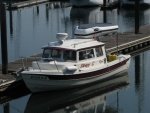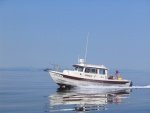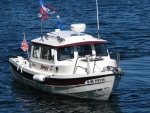Robert H. Wilkinson
Active member
- Joined
- Jan 26, 2011
- Messages
- 1,283
- Reaction score
- 0
- Vessel Name
- Romakeme IV
Saw a very interesting dory at the Tall Ship Days in Port Colborne Ontario. It was built by Barry Millar in 2002. Designed from a fishing dory popular in the early 1900's. Used in the Atlantic north of Boston.
It uses a single lung 2 stroke 3 hp motor that the owner restored to pristine condition. Hand started, constant speed of 800rpm.
A Kitchen Rudder controls speed, steerage and also acts as a stern thruster.
Some info can be found here - http://www.oldmarineengine.com/discus/m ... 95580.html
Also added some pictures of her in my album.
Beautiful boat.
Regards, Rob
It uses a single lung 2 stroke 3 hp motor that the owner restored to pristine condition. Hand started, constant speed of 800rpm.
A Kitchen Rudder controls speed, steerage and also acts as a stern thruster.
Some info can be found here - http://www.oldmarineengine.com/discus/m ... 95580.html
Also added some pictures of her in my album.
Beautiful boat.
Regards, Rob



